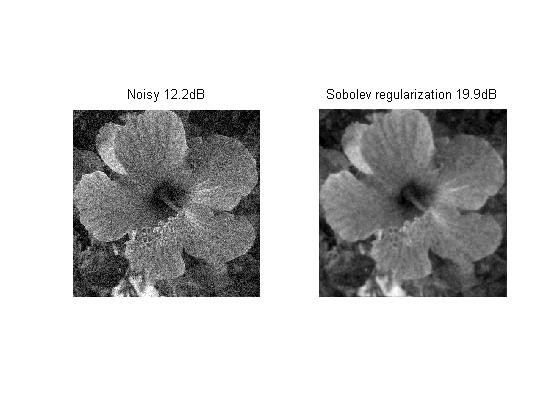First we discuss image prior's and regularization. Mr. Peyrê defines an image prior as the following:
"For a given image , a prior
assigns a score which is supposed to be small for the image of interest." (1) These priors can be used in denoising via the following formula:
"A denosing of some noisy image is obtained by a
variational minimization that mixes a fit to the data (usually using an
norm) and the prior. If
is a convex function of
,
then the minimum exists and is unique." (2) Next Mr. Peyrê introduces another parameter,
, to this process.
"The parameter
should be
adapted to the noise level. Increasing it's value means a more aggressive denoising. If
is a smooth
functional of the image
, a minimizer of this
problem can be computed be gradient descent. It defines a series of images
indexed by
as
It turns out that the necessary requirements for this process is work is that
is twice differentiable.
Now we get to see our first type of image prior - the Sobolev Prior. The Sobolec Prior is defined as:
The gradient vector here a point x is defined in the following manner:
In a discrete image of pixels, the gradient is calculated using the finite difference method. With this in mind, Mr. Peyrê loads the familiar hibiscus image and calcualtes the gradient of the image, as well as the absolute values of the gradient.

In the words of Mr. Peyrê, "Hear regularization smoothes the image using a low pass filter. Increasing the value for
increases the amount of smoothing." (4) Mr. Peyrê then proceeds to add some noise to the clean hibiscus image. Sobolev regularization is performed via the Fourier Transform. Mr. Peyrê gives the following
equation:
"This shows that is
a filtering of
." (5) Here is the resulting denoising.

Next, in typical fashion, Mr. Peyrê iterates through many values for in order to determine which value is
best.

Here is the denosing with the optimal value for :

Works Cited
(1) Peryê, Gabriel. "Denoising by Sobolev and Total Variation Regularization." Denoising by Sobolev and Total Variation Regularization. N.p., 2010. Web. 18 Aug. 2014.
(2) Peryê, Gabriel. "Denoising by Sobolev and Total Variation Regularization." Denoising by Sobolev and Total Variation Regularization. N.p., 2010. Web. 18 Aug. 2014.
(3) Peryê, Gabriel. "Denoising by Sobolev and Total Variation Regularization." Denoising by Sobolev and Total Variation Regularization. N.p., 2010. Web. 18 Aug. 2014.
(4) Peryê, Gabriel. "Denoising by Sobolev and Total Variation Regularization." Denoising by Sobolev and Total Variation Regularization. N.p., 2010. Web. 18 Aug. 2014.
(5) Peryê, Gabriel. "Denoising by Sobolev and Total Variation Regularization." Denoising by Sobolev and Total Variation Regularization. N.p., 2010. Web. 18 Aug. 2014.
G. Peyré, The Numerical Tours of Signal Processing - Advanced Computational Signal and Image Processing, IEEE Computing in Science and Engineering, vol. 13(4), pp. 94-97, 2011.